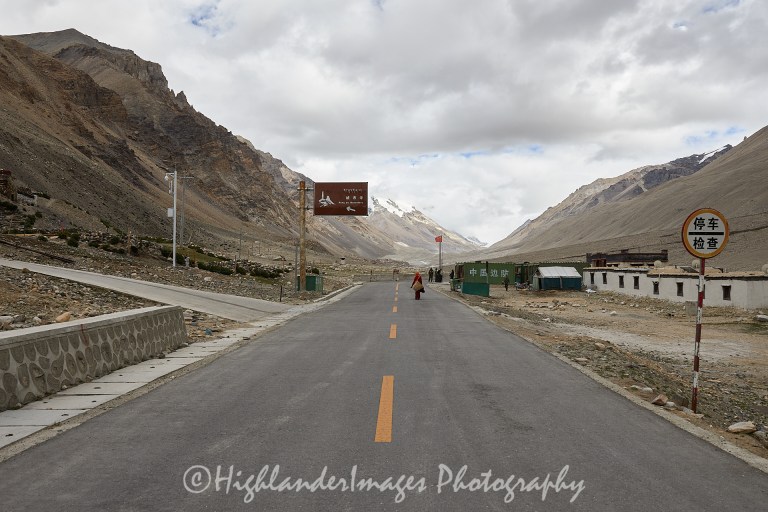
Rongphu Monastery (also known as Rongbuk Monastery) sits at a height of 5,000m on the road that runs up to Everest Base Camp in Tibet. It is a Tibetan Buddhist monastery of the Nyingma sect. It is claimed to be the highest monastery in the world. We stayed at the monastery guest house just opposite this monastery. We arrived late afternoon so we had time for a quick visit to the monastery and take a look inside. They were in the midst of renovation so there was a lot of building work going on and there were workers inside the buildings doing elaborate paintwork on the walls and on the the doors.




We paid our small entrance fee which then allowed us into the monastery and had an interesting walk around all the rooms. Just going up the few stairs in the building to the next level made is breathless due to the high altitude.


Rongbuk Monastery was founded in 1902 by the Nyingmapa Lama Ngawang Tenzin Norbu in an area of meditation huts and caves that had been in use by communities of nuns since the 18th century. Hermitage meditation caves dot the cliff walls all around the monastery complex and up and down the valley. Mani stone walls, carved with sacred syllables and prayers, line the paths.
The founding Rongbuk Lama, also known as Zatul Rinpoche, was much respected by the Tibetans. Even though the Rongbuk Lama viewed the early climbers as “heretics,” he gave them his protection and supplied them with meat and tea while also praying for their conversion. It was the Rongbuk Lama who gave Namgyal Wangdi the name Ngawang Tenzin Norbu, or Tenzing Norgay, as a young child.




In previous times, the Monastery became very active with Buddhist teachings at certain times of the year. It was, and is, the destination of special Buddhist pilgrimages where annual ceremonies are held for spectators coming from as far away as Nepal and Mongolia. These ceremonies were shared with satellite monasteries across the Himalaya also founded by the Rongbuk Lama. These ceremonies continue to this day, notably at the Sherpa Monastery at Tengboche.
Rongbuk Monastery was completely destroyed by the excesses of China’s Cultural Revolution (1966-1976) by 1974, and was left in ruins for several years, as recorded by photo-journalist Galen Rowell in 1981.



The monastery’s vast treasury of books and costumes, which had been taken for safekeeping to Tengboche, was lost in a 1989 fire.
Since 1983 renovation work has been carried out and some of the new murals are reportedly excellent. Adjacent to the monastery there is a basic guesthouse and small but cosy restaurant.
According to Michael Palin, it now houses thirty Buddhist monks and thirty nuns, but another source reports that locals say there are only about 20 nuns and 10 monks, although previously there were about 500 monks and nuns living here.
In 2011, Rongbuk Monastery was ranked at the top of CNN’s ‘Great Places to be a Recluse’.



It was interesting to watch the workers do the beautiful paintwork on the walls and do the finely detailed gold paintwork on the doors.








The monastery guest house was a low building on the opposite side of the road from the monastery and had a number of rooms plus a restaurant.





The room was very simple and basic with no toilet – for that you had to venture outside the main building to a very basic squat toilet in an outhouse. However our beds did come with electric blankets which was a real luxury.


The small restaurant served some basic food and we had a simple dinner here in the evening. The walls and ceilings were colourfully decorated making it very cosy.






From the monastery and the guesthouse you can get dramatic views on the north face of Mount Everest but it was very cloudy when we arrived so we could not see the peak initially.

However after dinner and as the light was almost gone the clouds cleared and we could at last get our first real glimpse of the magnificent mountain of Everest.
Passionate Photographer …. Lost in Asia
Stuart Taylor of HighlanderImages Photography has been making images for over 30 years and can offer a diverse range of photo imaging services with a focus on Asia and a documentary/photojournalistic style. These services include planning and executing a photo shoot on location but importantly all the post-processing and image preparation needed for the specific finished media format required by the customer. Stuart’s experience and knowledge in all of these aspects makes HighlanderImages Photography a one-stop-shop for a comprehensive and professional image production service.
Stuart can be available for a variety individual assignments or projects and he specialises in areas such as photojournalism, commercial, architectural, real estate, industrial, interior design, corporate, urbex, adventure, wilderness and travel photography.
Final image products can be delivered as high resolution images, prints, books, multimedia slideshows, videos and DVDs. Images from this website can be purchased as prints in a variety of sizes and media, as gift items or as digital downloads.
E-Mail : staylor@highlanderimages.com
Website : http://www.highlanderimages.com


2 thoughts on “Rongphu Monastery, Tibet”